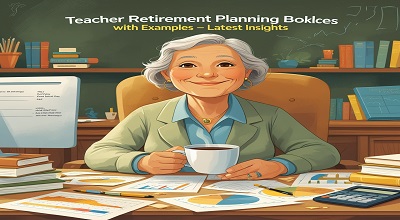Teacher Retirement Planning
Teacher Retirement Planning: Retirement can seem like a distant goal, especially for teachers who dedicate their lives to education. However, proper retirement planning is essential to ensure that teachers can enjoy their retirement years with financial stability and peace of mind. In this blog post, we’ll delve into the importance of retirement planning for teachers, explore real-life examples of successful retirement strategies, and provide practical advice on how teachers can prepare for their future after they leave the classroom.
Why Teacher Retirement Planning is Crucial?
- The Challenge of Teacher Salaries: Teachers often face the challenge of lower salaries compared to other professions. As such, planning for retirement early is essential to ensure a comfortable lifestyle post-retirement.
- Pension Systems and Their Limitations: While many teachers have access to pension systems, these benefits may not always be sufficient to meet the demands of retirement. Understanding these systems is a key step in teacher retirement planning.
- Inflation and Cost of Living: With rising inflation, it’s vital for teachers to plan their retirement savings to keep up with the increasing cost of living.
Key Steps for Effective Teacher Retirement Planning
- Start Early: The earlier teachers begin saving, the more time their investments have to grow. Compound interest plays a vital role in building a strong retirement fund.
- Understand Pension Plans: Teachers often have pension plans as part of their benefits package. It’s important to fully understand the pension structure, how much teachers will receive after retirement, and the age at which they can start drawing these benefits.
- Maximize Employer Contributions: Many school systems contribute to retirement plans. Teachers should be aware of these benefits and try to maximize their employer contributions to secure more funds for the future.
- Diversify Retirement Accounts: Teachers should not rely solely on pensions. Instead, they should consider opening individual retirement accounts (IRAs), 403(b) plans, or other investment accounts to diversify their retirement savings.
- Assess Retirement Goals: Teachers should estimate their desired retirement lifestyle. This includes considering healthcare costs, travel, hobbies, and other personal goals. Creating a budget for these activities will give teachers an idea of how much they need to save.
Types of Retirement Plans for Teachers
- Pension Plans: Many teachers have access to a pension plan, a type of defined benefit plan. It provides a fixed monthly benefit once teachers retire. Understanding how these pensions are calculated and when teachers are eligible to begin receiving them is essential.
- 403(b) Plans: This is a type of tax-deferred retirement plan specifically designed for educators and other public sector employees. Teachers can contribute to these plans through automatic payroll deductions, and their contributions grow tax-deferred until retirement.
- IRAs (Individual Retirement Accounts): Teachers can also open traditional or Roth IRAs to supplement their pensions. Roth IRAs, in particular, offer the advantage of tax-free withdrawals in retirement.
Examples of Effective Retirement Planning for Teachers
- Example 1: Jane, The Early Planner: Jane, a high school teacher, started contributing to her 403(b) plan at the age of 25. By the time she retired at 60, she had accumulated significant savings due to the power of compound interest and regular contributions. Jane’s early start allowed her to have a comfortable retirement despite relying solely on her pension for the first few years.
- Example 2: John, The Late Planner: John, on the other hand, didn’t start saving for retirement until he was 45. While he still had a pension, he realized he needed to catch up on his savings. He started contributing the maximum to his 403(b) and opened a Roth IRA. With aggressive saving and careful investing, John was able to retire with a strong financial foundation, even though he started later than most.
Common Pitfalls in Teacher Retirement Planning and How to Avoid Them
- Not Starting Early: One of the biggest mistakes teachers make is delaying retirement savings. Without the power of compound interest, teachers may not have enough to retire comfortably.
- Underestimating Healthcare Costs: Teachers often overlook the cost of healthcare in retirement. With medical expenses rising, it’s important to plan for these costs separately from everyday living expenses.
- Relying Solely on Pension: While pensions are helpful, they are often not enough on their own to cover all retirement expenses. Diversifying savings across different investment accounts can ensure financial security.
Financial Planning Tools for Teachers
- Retirement Calculators: Teachers can use online retirement calculators to estimate how much they need to save each month to meet their retirement goals.
- Budgeting Tools: Budgeting tools can help teachers track their income and expenses, ensuring that they are setting aside enough money for retirement.
- Financial Advisors: Working with a financial advisor who understands the unique needs of teachers can provide personalized retirement planning strategies.
Teacher Retirement Planning Checklist
- Review your pension plan and understand its benefits.
- Open a 403(b) or IRA to supplement your pension.
- Start saving early, even if it’s a small amount.
- Set clear retirement goals and plan your budget accordingly.
- Seek professional advice when necessary.
Key Takeaways
Teacher retirement planning is crucial for ensuring a comfortable and stress-free retirement. By starting early, understanding pension plans, and diversifying savings, teachers can build a strong financial foundation for their future. It’s never too early to start, and with the right planning and tools, teachers can retire confidently.
Visit Here: Undead Slayer Extreme Mod Apk
